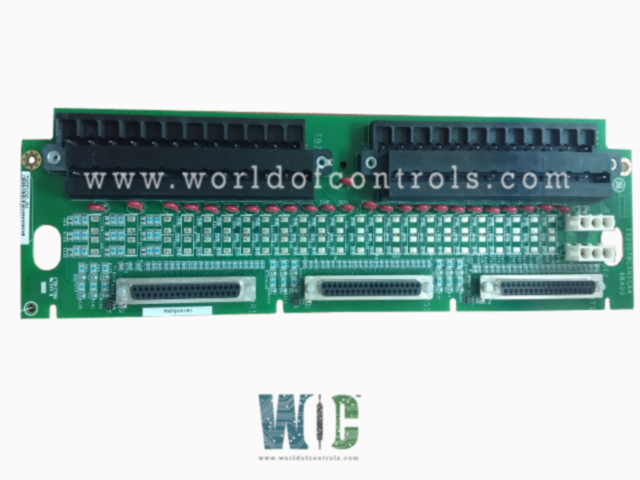SPECIFICATIONS
Part No.: IS200TBCIH1CBC
Manufacturer: General Electric
Country of Manufacture: United States of America (USA)
Size: 33.02 cm high x 10.16 cm wide
Temperature: -30 to 65oC
Product Type: Contact Input Terminal Board
Availability: In Stock
Series: Mark VI
Functional Description
IS200TBCIH1CBC is a Contact Input Terminal Board developed by GE. It is part of the Mark VI series.Terminal Board for Contact Input with Group Isolation serves as a crucial component within the system architecture, specifically designed to handle contact inputs while ensuring isolation and protection against potential faults. Here's a detailed breakdown of its functionalities and fault detection mechanisms:
Features
- Input Acceptance: The board accommodates 24 dry contact inputs, which are systematically wired to two barrier-type terminal blocks. These inputs are designed to accept and process external signals.
- Contact Excitation: For the excitation of contact inputs, a DC power source is wired to the board, ensuring proper functioning and activation of the contact inputs.
- Noise Suppression Circuitry: Contact inputs are equipped with noise suppression circuitry. This feature safeguards against surge and high-frequency noise, ensuring reliable signal processing and protection against potential electrical disturbances.
- Hardware Settings: Notably, the terminal board does not feature any jumpers or hardware settings. This design simplifies configuration and setup, ensuring straightforward integration within the system.
- Power Consumption: Consumes a total power of 20.6 watts while operating, facilitating the necessary functionalities and signal processing within the board.
Cabling Connections
- In a simplex system configuration, connector JR1 serves as the primary connection point. However, in a Triple Modular Redundant (TMR) setup, all three connectors - JR1, JR2, and JR3 - are utilized to ensure redundancy and fault tolerance. The choice of connectors depends on the specific requirements of the Mark VI or Mark VIe system being deployed, as well as the desired level of redundancy.
- Cables or Input/Output (I/O) packs are then plugged into these connectors based on the system's architecture and the redundancy strategy employed. This flexible approach allows for seamless integration and scalability, accommodating different system configurations and operational needs.
Fault Detection Mechanisms
- Loss of Contact Input Excitation Voltage: Detection occurs when there's a loss of excitation voltage powering the contact inputs, ensuring continuous monitoring and reliability of the input voltage levels.
- Non-Responding Contact Input in Test Mode: Detection flags a non-responsive contact input specifically during test modes, ensuring functionality verification and responsiveness during diagnostic procedures.
- Unplugged Cable: Fault detection is triggered in case of an unplugged cable, ensuring that the system can identify and address any disruptions in connectivity or signal transmission.
- These fault detection mechanisms within the TBCI terminal board are integral for maintaining the reliability and safety of contact inputs. By promptly identifying potential issues such as power loss or connectivity disruptions, these mechanisms ensure system stability and operational consistency, contributing significantly to the overall reliability of the system.
The WOC team is always available to help you with your Mark VI requirements. For more information, please contact WOC.
Frequently Asked Questions
What is IS200TBCIH1CBC?
It is a Contact Input Terminal Board developed by GE under the Mark VI series.
What happens during a test scenario involving the inputs associated with the terminal board?
In a diagnostic test scenario, all inputs connected to this terminal board are forcefully placed in the open contact state, typically a fail-safe state. Any input that fails this diagnostic test is also forced into the fail-safe state, triggering a fault notification.
How is voting integrity maintained across the three boards associated with the TBCI inputs?
If the input values from this specific board do not align with the Triple Modular Redundancy (TMR) voted value obtained from all three boards, a fault is generated. This ensures consistency and confirms the integrity of the inputs across the redundant systems.
